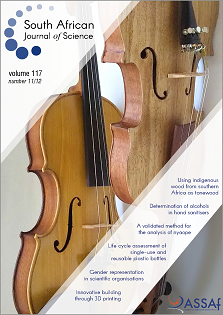Developing an environmental research platform in the Karoo at the Square Kilometre Array
DOI:
https://doi.org/10.17159/sajs.2021/10511Keywords:
drylands, ecosystem re-organisation, environmental change, long-term ecological research, Nama-KarooAbstract
A part of the Square Kilometre Array (SKA) will be constructed in the northern Karoo of South Africa on approximately 135 000 ha of land. This land is formerly privately owned rangelands (farms) that were purchased by the South African National Research Foundation (NRF), on which the South African Radio Astronomy Observatory, as part of the global SKA project, will erect the SKA infrastructure. Additionally, a long-term environmental research programme will be established to investigate various dryland ecosystem components at a landscape scale. Livestock has been removed from the farms, and the area is now managed by the South African National Parks (SANParks) as the Meerkat National Park. The land-use and land cover changes present an unprecedented opportunity to study ecosystem dynamics. The property will be established as an NRF science park, incorporating an SKA research platform for radio astronomy and an environmental research platform of the South African Environmental Observation Network, with additional environmental research conducted by SANParks and their collaborators. We briefly describe current knowledge of the area’s environment, and report on past and contemporary changes in this part of the Karoo. We present a conceptual model for the larger landscape which considers possible future land-use scenarios, the projected trajectories of change under these scenarios, and factors influencing these trajectories. These deliberations represent the foundation for future research in this landscape and the development of an environmental observation research platform in the Karoo at SKA.
Significance:
- We summarise an extensive environmental baseline report on the SKA property and surrounding areas.
- Withdrawal of livestock and other changes – such as clearing of alien invasive plants, reduced predator control and reduction in water-point maintenance – are expected to bring about changes in ecological processes and plant and animal communities.
- We present a conceptual model of scenarios to test possible future trajectories as a first step towards an earth system science research platform in the NRF science park.
Downloads
Published
Issue
Section
License

All articles are published under a Creative Commons Attribution 4.0 International Licence
Copyright is retained by the authors. Readers are welcome to reproduce, share and adapt the content without permission provided the source is attributed.
Disclaimer: The publisher and editors accept no responsibility for statements made by the authors
How to Cite
- Abstract 846
- PDF 754
- EPUB 240
- XML 254
- Supplementary material 150












.png)